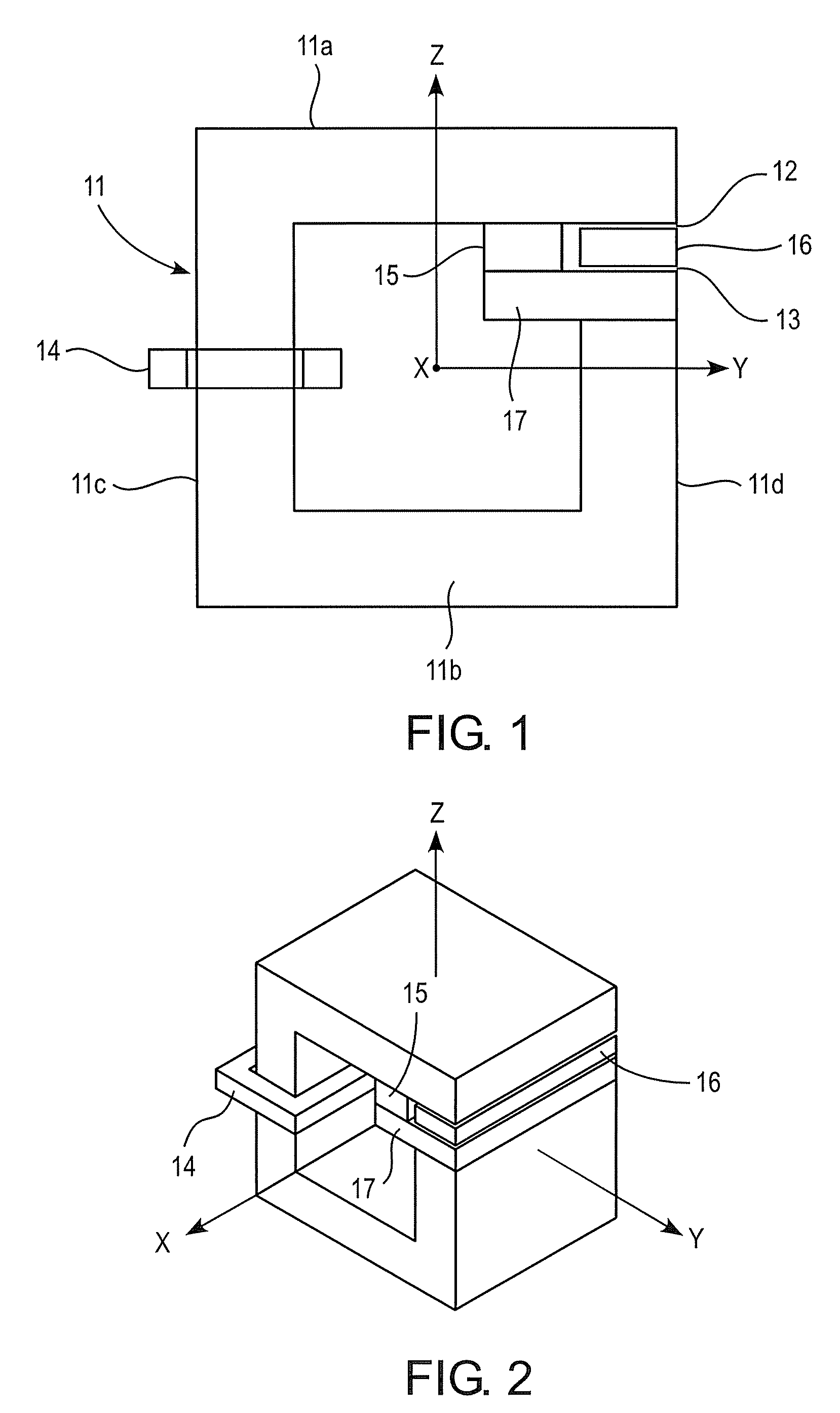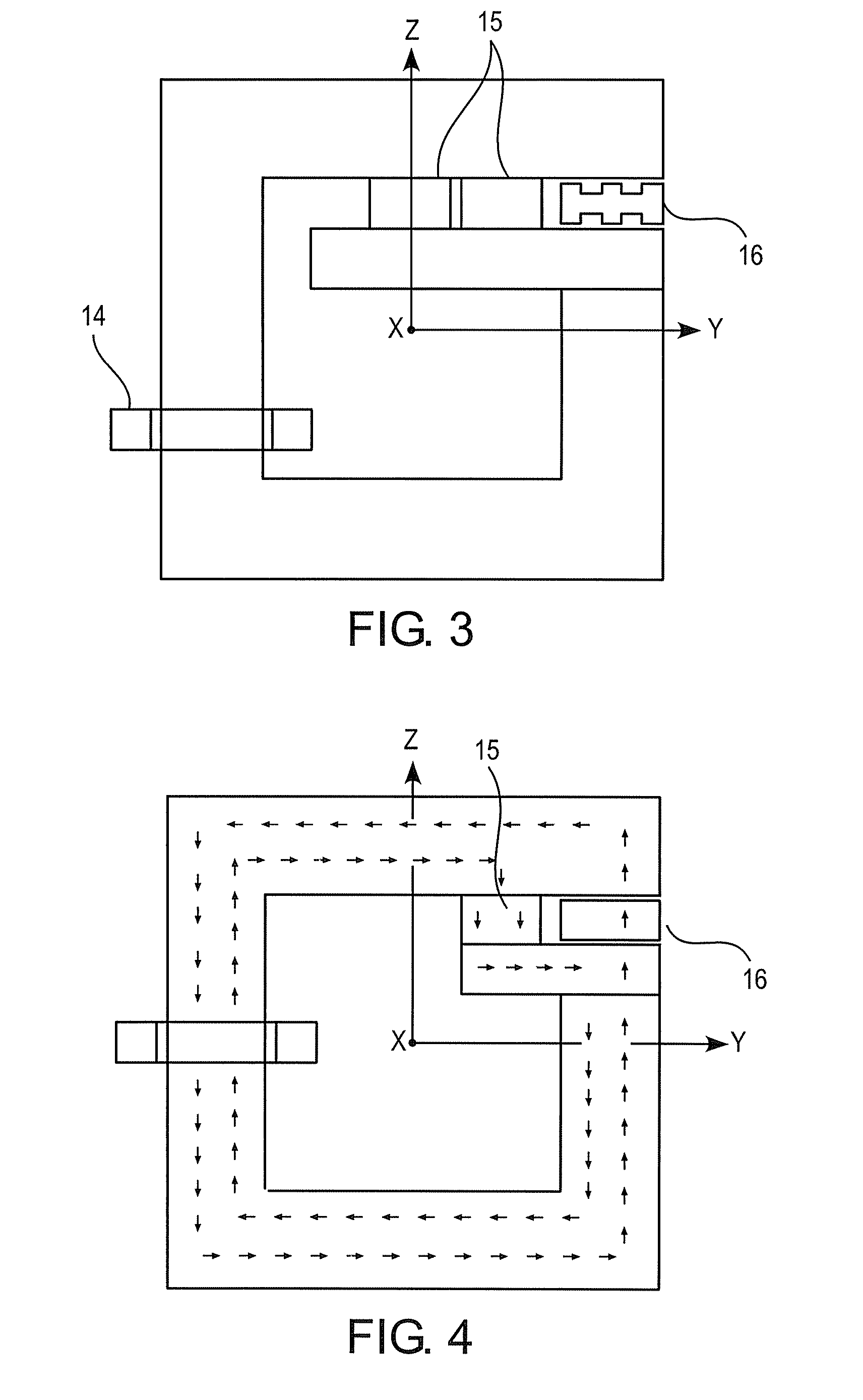DC inductor
a technology of inductors and inductors, applied in the direction of transformers/inductance details, inductances, inductances with magnetic cores, etc., can solve the problems of mechanical failure of the attachment of permanent magnets, and achieve the effect of saving the production of inductors
- Summary
- Abstract
- Description
- Claims
- Application Information
AI Technical Summary
Benefits of technology
Problems solved by technology
Method used
Image
Examples
first embodiment
FIG. 1 shows the DC inductor according to the present invention. The core structure 11 is formed of a magnetic material, i.e. material that is capable of leading a magnetic flux. The material can be for example laminated steel commonly used in large inductors and as stator plates in motors, soft magnetic composite or iron powder.
The DC inductor of the invention comprises at least one coil 14 inserted on the core structure and one or more magnetic gaps 12, 13. The coil is typically wound on a bobbin and then inserted on the core structure in a normal manner. Alternatively, the coil can be wound directly to the core without a bobbin. The gaps are formed on the main magnetic path, by which it is referred to the magnetic path the magnetic flux of the coil flows. In the present invention, at least one of the possibly multiple magnetic gaps are formed by using magnetic slabs. In the embodiment of FIG. 1, the magnetic slab 16 is a separate piece that can be inserted into the core structure...
third embodiment
FIG. 6 shows the DC inductor according to the present invention. In this embodiment, two supporting members 33, 34 are supporting two permanent magnets 35, 36. The supporting members extend parallel to the core structure and inside the core structure. In this embodiment, the supporting members are also extended to outside of the core structure to hold other permanent magnet outside of the core structure.
The supporting members are extending from one leg of the core structure as shown in FIG. 6. The magnetic slab which produces one or more magnetic gaps is located according to the invention between the permanent magnets 35, 36 and the supporting members 33, 34.
FIG. 6 indicates the flux paths of the fluxes produced by the coil 38 and the permanent magnets 35, 36. The directions of the fluxes oppose each other, and the flux generated by the coil travels through the magnetic slab 37 while the flux of the permanent magnets flows through the supporting members 33, 34. Thus in the normal op...
fourth embodiment
FIG. 8 shows the DC inductor according to the present invention. In this embodiment the core structure comprises three legs 41, 42 and 43 and is basically an I-W core. The I-part of the core is situated on the top of the W-core, with the supporting member arranged on the center leg 43. Supporting member 44, which extends in parallel relationship with the core structure, further holds the permanent magnets 45, 46. The permanent magnets are between the supporting member and the core structure, especially the underside of the I-core.
In the embodiment shown in FIG. 8, the supporting member holds both the permanent magnets and the magnetic slab. The magnetic slab is used to form the magnetic gaps 47 to the center leg of the core structure.
The embodiment of FIG. 8 can be further modified by substituting the I-part with a T-part. That is to say that the magnetic slab of FIG. 8 is attached or made uniform with the I-part to produce the T-part. In this modification, the supporting member is ...
PUM
| Property | Measurement | Unit |
|---|---|---|
| magnetic gaps | aaaaa | aaaaa |
| magnetization | aaaaa | aaaaa |
| magnetic | aaaaa | aaaaa |
Abstract
Description
Claims
Application Information
 Login to View More
Login to View More - R&D
- Intellectual Property
- Life Sciences
- Materials
- Tech Scout
- Unparalleled Data Quality
- Higher Quality Content
- 60% Fewer Hallucinations
Browse by: Latest US Patents, China's latest patents, Technical Efficacy Thesaurus, Application Domain, Technology Topic, Popular Technical Reports.
© 2025 PatSnap. All rights reserved.Legal|Privacy policy|Modern Slavery Act Transparency Statement|Sitemap|About US| Contact US: help@patsnap.com



